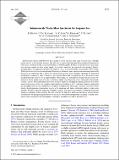Submesoscale Water-Mass Spectra in the Sargasso Sea
Author(s)
Kunze, E.; Klymak, J. M.; Lien, Ren-Chieh; Lee, C. M.; Sundermeyer, M. A.; Goodman, L.; Ferrari, Raffaele; ... Show more Show less
DownloadKunze-2015-Submesoscale Water-M.pdf (2.721Mb)
PUBLISHER_POLICY
Publisher Policy
Article is made available in accordance with the publisher's policy and may be subject to US copyright law. Please refer to the publisher's site for terms of use.
Terms of use
Metadata
Show full item recordAbstract
Submesoscale stirring contributes to the cascade of tracer variance from large to small scales. Multiple nested surveys in the summer Sargasso Sea with tow-yo and autonomous platforms captured submesoscale water-mass variability in the seasonal pycnocline at 20–60-m depths. To filter out internal waves that dominate dynamic signals on these scales, spectra for salinity anomalies on isopycnals were formed. Salinity-gradient spectra are approximately flat with slopes of −0.2 ± 0.2 over horizontal wavelengths of 0.03–10 km. While the two to three realizations presented here might be biased, more representative measurements in the literature are consistent with a nearly flat submesoscale passive tracer gradient spectrum for horizontal wavelengths in excess of 1 km. A review of mechanisms that could be responsible for a flat passive tracer gradient spectrum rules out (i) quasigeostrophic eddy stirring, (ii) atmospheric forcing through a relict submesoscale winter mixed layer structure or nocturnal mixed layer deepening, (iii) a downscale vortical-mode cascade, and (iv) horizontal diffusion because of shear dispersion of diapycnal mixing. Internal-wave horizontal strain appears to be able to explain horizontal wavenumbers of 0.1–7 cycles per kilometer (cpkm) but not the highest resolved wavenumbers (7–30 cpkm). Submesoscale subduction cannot be ruled out at these depths, though previous observations observe a flat spectrum well below subduction depths, so this seems unlikely. Primitive equation numerical modeling suggests that nonquasigeostrophic subinertial horizontal stirring can produce a flat spectrum. The last need not be limited to mode-one interior or surface Rossby wavenumbers of quasigeostrophic theory but may have a broaderband spectrum extending to smaller horizontal scales associated with frontogenesis and frontal instabilities as well as internal waves.
Date issued
2015-05Department
Massachusetts Institute of Technology. Department of Earth, Atmospheric, and Planetary SciencesJournal
Journal of Physical Oceanography
Publisher
American Meteorological Society
Citation
Kunze, E., J. M. Klymak, R.-C. Lien, R. Ferrari, C. M. Lee, M. A. Sundermeyer, and L. Goodman. “Submesoscale Water-Mass Spectra in the Sargasso Sea.” Journal of Physical Oceanography 45, no. 5 (May 2015): 1325–1338. © 2015 American Meteorological Society
Version: Final published version
ISSN
0022-3670
1520-0485